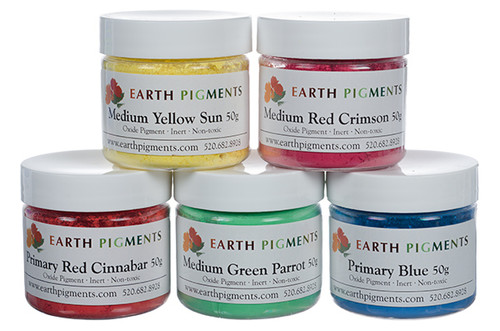Product Details
Usage List
- Acrylics
- Alcohols
- Calligraphy ink
- Candle overdipping
- Casein
- Cements: compatible but limited tinting strength
- Clay paints and plasters
- Distemper
- Egg tempera
- Encaustic
- Epoxy resins
- Fabric: use in paints but not as dye
- Flour paints
- Fresco
- Glazes
- Glue paint
- Iconography
- Lime Coatings: compatible but limited tinting strength
- Milk Paints
- Oil Mediums: moderately high oil absorption
- Oil paints
- Pastels
- Paste wax
- Plastic resins
- Polymer Clay
- Resins
- Shellac
- Soap
- Solvents
- Stains
- Swedish Paint
- Temperas
- Water based Mediums
- Watercolor
- Waxes
Don’t see what you are looking for? Send us a question
Mixing Instructions
For liquid binders: Place desired amount of pigment in mixing vessel or on a palette. Add liquid slowly and work with palette knife or tool to create a smooth color paste or syrup. The liquid used may be either the binder itself or a compatible vehicle depending upon the chosen medium. To avoid flocculation, do not introduce pigments into a large volume of liquid all at once as this will cause micro clumping.
For dry binders such as plasters and cements: Pigment may be added into dry ingredients directly prior to mixing. If micro-bursting of particles appears in plasters, creating a color syrup may be necessary first.
Mixing tools: Artist mixing tools may include a palette with a palette knife, a mortar and pestle or a slab and muller. Which tool you use depends upon the amount mixed and the pigment’s need for mulling. Decorative binders may require the use of mechanical mixers to fully incorporate pigment.
Ratios: To be determined by individual binders and/or color result desired. Visit our How-To pages for in-depth recipes with suggested ratio's and detailed instructions.
What are Natural Earths and Ochers?
Natural Earths and Ochers are pigments used since Prehistory. Found on five continents, their color depends upon their composition of minerals. These mineral colors are primarily from clay soils and sands. After their extraction, they are washed and separated from their soil components to isolate the minerals, then ground fine and packaged. Certain colors can be found in more abundance in certain regions. For example, Ochers from France, Umbers from Cyprus and Red Earths from India.
See: How French Ochers are manufactured.
One property attributable to Natural Earths and Ochers is their semi-transparent nature, making them sought after by fine artists throughout history. They have often been utilized in decorative coatings as well. One most notable example would be France, where Ochers have historically been applied to buildings using the fresco technique to realize their full color potential. Their versatility is in their permanent nature and ability to be stable in any medium. Natural Earths and Ochers are not strong tinters in opaque bases like plasters and cements, but instead reveal soft, natural undertones. Our USA colors (Raw Umber USA, Burnt Umber USA and Burnt Sienna USA) are a little stronger due to their unique opacity among Natural Earths.







